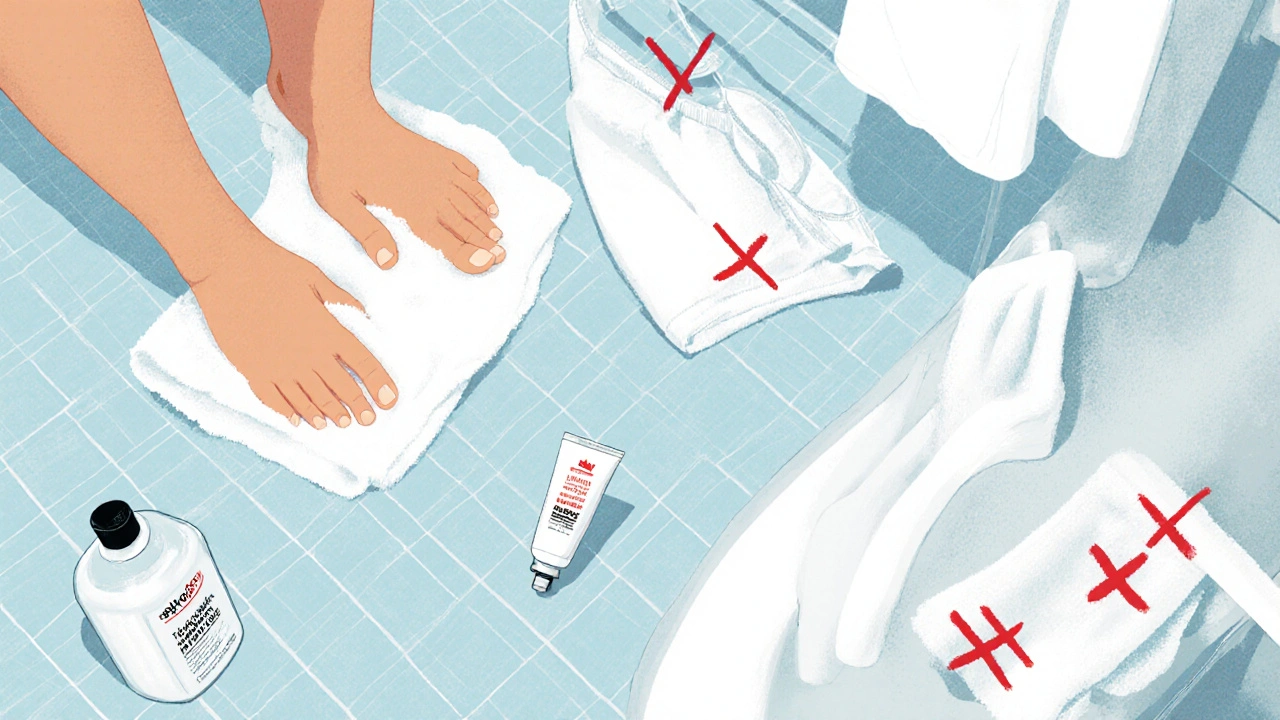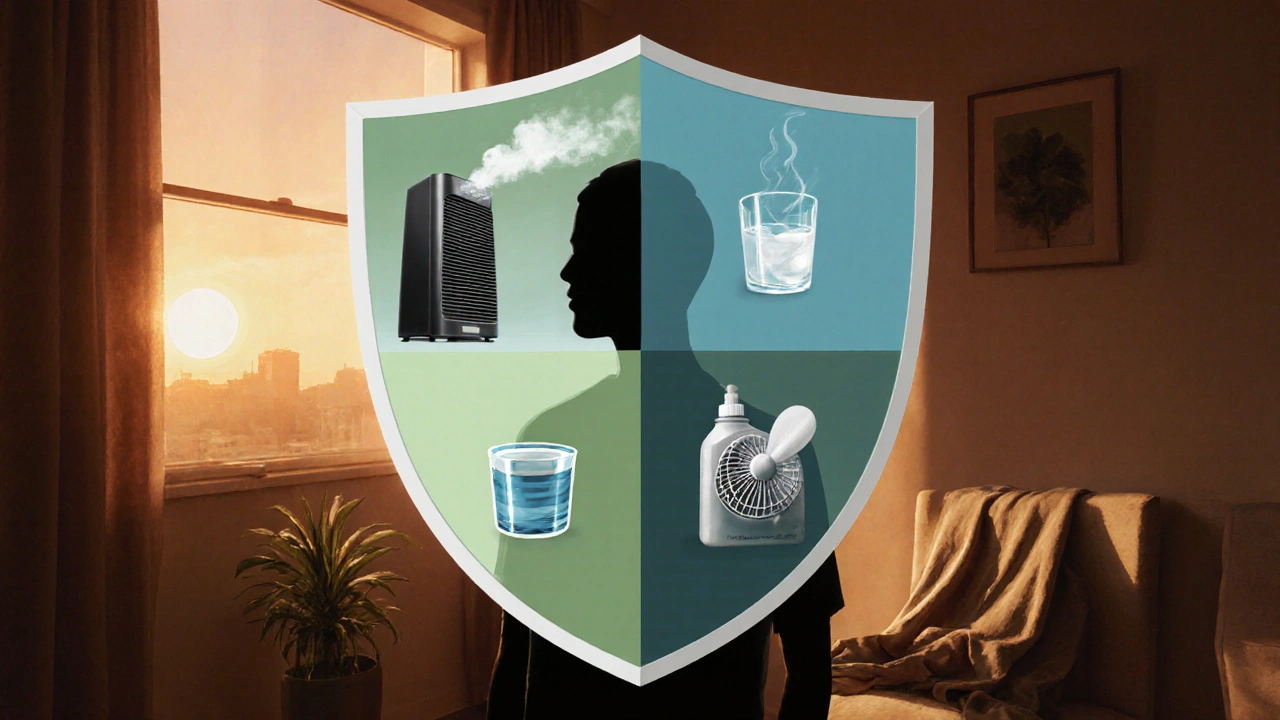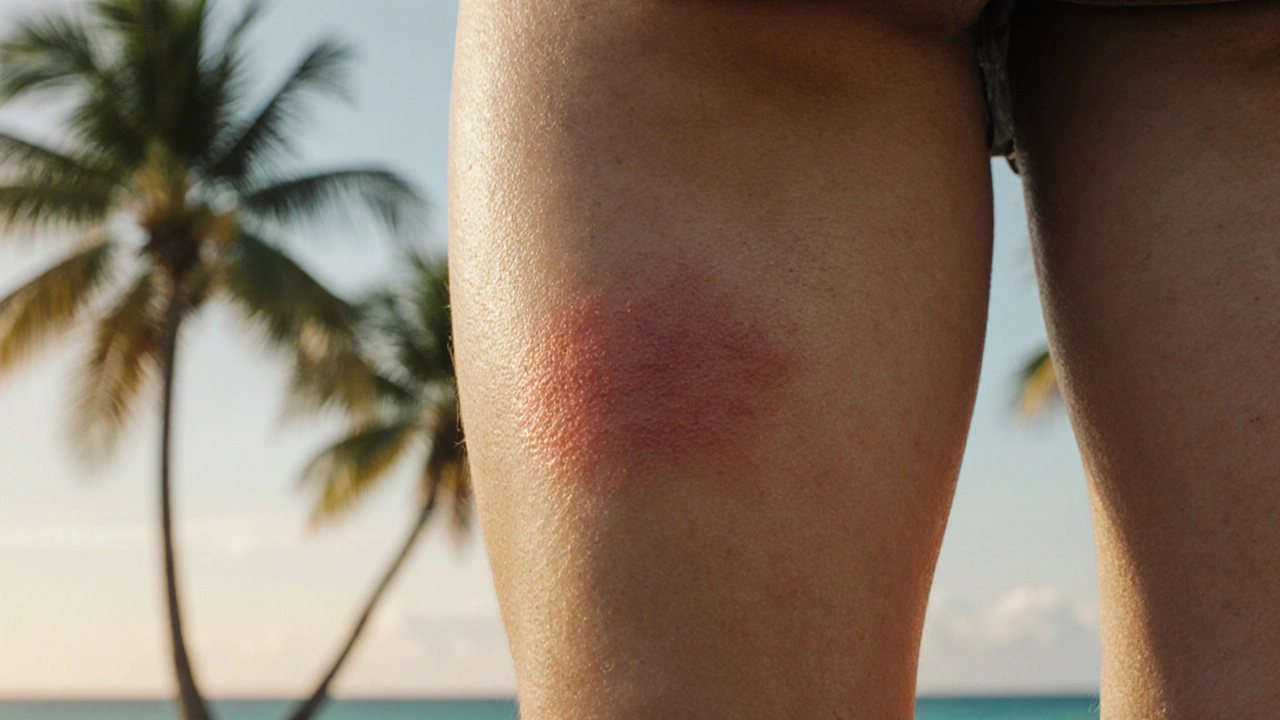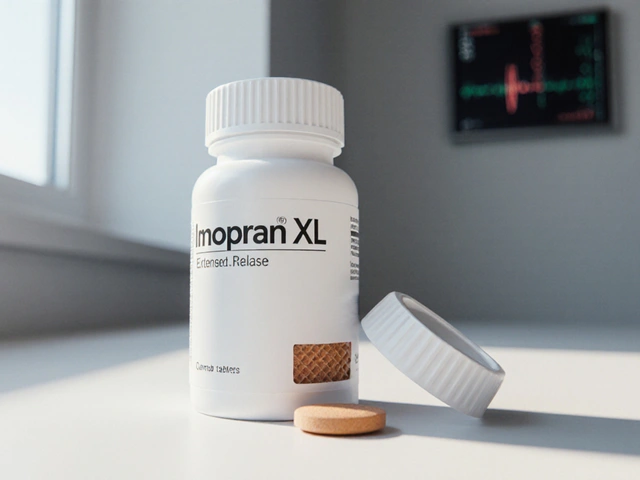Skin Yeast Infection Risk Calculator
Your Risk Assessment
Living where the air feels like a sauna can be great for the beach, but it also makes skin problems pop up faster. One nuisance that loves heat and moisture is a yeast infection of the skin, also known as cutaneous candidiasis. If you’ve ever noticed a itchy red rash in skin folds, it’s often that stubborn fungus taking advantage of the wet environment. Below you’ll find practical ways to prevent yeast infections without giving up comfort.
TL;DR - Quick Wins
- Stay dry: change out of sweaty clothes, use powder or antiperspirant on problem areas.
- Choose breathable fabrics like cotton or moisture‑wicking blends.
- Use gentle, antifungal‑friendly cleansers and moisturizers.
- Limit sugary foods and add probiotic‑rich items to your diet.
- Control indoor humidity with fans or a dehumidifier.
What Is a Skin Yeast Infection?
When most people hear “yeast infection” they think of vaginal issues, but Candida albicans is a type of yeast that lives harmlessly on our skin, mouth, and gut. Under normal conditions it’s kept in check by the skin’s natural barrier and the good bacteria that share the space. If the environment becomes too warm, moist, or sugary, Candida can overgrow, causing redness, itching, and sometimes a white‑ish discharge. This condition is medically called cutaneous candidiasis.
Why Heat and Humidity Invite Trouble
Hot, humid climates create the perfect breeding ground for yeast. Here’s how:
- Humidity increases the amount of moisture on the skin’s surface, softening the outer layer (the skin barrier) and making it easier for yeast to penetrate.
- When you sweat, the water evaporates slowly in high humidity, leaving your skin wet for longer periods.
- Sticky sweat mixes with natural oils and can trap yeast in skin folds - under the bra, between thighs, around the groin, or under a backpack strap.
Those three factors combine to turn a harmless resident into a persistent irritant.
Everyday Habits to Keep Your Skin Dry
Dry skin isn’t about being bone‑dry; it’s about avoiding prolonged dampness. Try these routine tweaks:
- Shower at least once a day and use a mild, antifungal‑friendly soap. Rinse thoroughly and avoid leaving soap residue.
- After bathing, pat skin dry with a clean towel, paying extra attention to folds and between toes.
- Change out of sweaty clothes immediately after exercise, work, or any activity that makes you drip.
- Apply a light coating of talc‑free powder (or a cornstarch‑based body powder) to problem areas. It absorbs excess moisture without clogging pores.
- Consider an antiperspirant on the under‑arms, chest, and back if you’re a heavy sweater.
Choosing the Right Clothing
What you wear can either trap moisture or help it escape. Opt for:
- Breathable clothing, such as 100% cotton, bamboo, or technical fabrics designed to wick sweat away from the skin.
- Loose‑fitting garments that don’t rub or hold skin together.
- Avoiding synthetic fabrics like polyester in hot weather unless they are specifically labeled moisture‑wicking.
- Changing socks at least once a day; cotton socks retain moisture, so a blend with synthetic fibers can keep feet drier.

Skin Care Products That Help (and Those to Skip)
Not every lotion or cleanser is created equal. Look for products that:
- Are fragrance‑free and dye‑free - fragrances can irritate already sensitive skin.
- Contain soothing ingredients like Aloe vera or calamine to reduce itching.
- Have an antifungal cream (e.g., clotrimazole 1%) on hand for a quick spot‑treatment if a rash appears.
Skip heavy occlusive creams (like petroleum jelly) on areas prone to sweating, as they seal in moisture.
Diet, Probiotics, and Sugar Management
What you eat can influence the yeast balance inside your body. While diet alone won’t cause a skin infection, it can tip the scales:
- Reduce high‑glycemic foods (white bread, soda, candy) that feed Candida.
- Include probiotic‑rich foods such as yogurt with live cultures, kefir, sauerkraut, or a daily probiotic supplement with Lactobacillus strains.
- Stay hydrated - water helps flush excess sugars and supports healthy skin turnover.
Controlling Your Environment
If you can’t change the weather, you can manage indoor humidity:
- Run a fan or air conditioner during the hottest parts of the day.
- Use a dehumidifier in bedrooms or living spaces that feel clammy.
- Open windows at night when outside humidity drops.
- Avoid leaving wet towels or clothes piled up; they release moisture into the air.
When to Seek Medical Help
If you notice any of the following, it’s time to see a clinician:
- Rash that spreads quickly or doesn’t improve after a week of home care.
- Severe burning, pain, or open sores.
- Fever or chills accompanying the skin irritation.
- Repeated infections despite careful hygiene.
Doctors may prescribe a stronger topical antifungal, oral medication, or investigate underlying conditions like diabetes that can predispose you to recurrent yeast growth.
Quick Prevention Checklist
- Shower daily with a gentle, antifungal‑compatible cleanser.
- Pat (don’t rub) skin dry, especially in folds.
- Use powder or antiperspirant on moisture‑prone spots.
- Wear breathable, loose clothing; change out of sweaty gear promptly.
- Keep indoor humidity below 60% with fans or a dehumidifier.
- Limit sugar, include probiotic foods, and stay hydrated.
- Keep an over‑the‑counter antifungal cream on hand for breakout emergencies.
Frequently Asked Questions
Can I treat a skin yeast infection with natural oils?
Tea tree oil and coconut oil have antifungal properties, but they can also irritate sensitive skin if not diluted. Use a carrier oil and test on a small area first. For mild cases they may help, but a proven antifungal cream is more reliable.
How often should I change my socks in a humid climate?
Ideally twice a day - once in the morning and once after any activity that makes your feet sweat. Choose moisture‑wicking socks and let shoes air out overnight.
Is a dehumidifier worth the investment?
If indoor humidity consistently stays above 60%, a small portable dehumidifier can cut down skin moisture and lower the chance of fungal growth. Look for units that auto‑shutoff and have a humidity sensor.
Can I still go swimming without risking a yeast infection?
Yes, but rinse off with fresh water right after swimming, dry the skin thoroughly, and apply powder to folds. Chlorinated pools are less likely to promote yeast than warm, stagnant water.
What’s the best over‑the‑counter antifungal cream?
Clotrimazole 1% or miconazole 2% are widely available and effective for most skin candidiasis. Follow the package directions - usually twice daily for two weeks, even if the rash looks better sooner.

Comparing Common Prevention Strategies
| Method | Effectiveness* | Ease of Use | Typical Cost |
|---|---|---|---|
| Keep skin dry (powder, quick‑dry clothes) | High | Easy | Low |
| Apply over‑the‑counter antifungal cream | Very High | Moderate | Low-Medium |
| Use breathable fabrics | Medium | Easy | Low‑Medium |
| Probiotic‑rich diet / supplements | Medium | Moderate | Low‑Medium |
| Control indoor humidity (dehumidifier, fan) | High | Moderate | Medium‑High |
*Effectiveness based on typical results reported in dermatology studies and user surveys.
Mix and match these strategies based on your lifestyle and budget. The key is consistency - the more often you keep skin dry and limit yeast‑friendly conditions, the less likely you’ll see that irritating rash.






zaza oglu
October 2, 2025 AT 17:07 PMLiving in a steamy climate can feel like constantly wearing a sauna suit, and that humidity is a perfect breeding ground for skin yeast.
One of the simplest tricks is to keep the skin as dry as possible right after you sweat.
Swap out heavy cotton tees for moisture‑wicking shirts that pull sweat away from the surface.
When you get home, change into fresh, breathable clothes within minutes, not hours.
A light dusting of talc‑free powder on problem areas works like a silent bodyguard, sucking up excess moisture.
Don't forget to pat-not rub-your skin dry, especially in folds where water loves to linger.
If you’re a heavy sweater, an antiperspirant isn’t just for underarms; a swipe on your back or chest can make a huge difference.
Keeping indoor humidity below 60 % with a fan or dehumidifier cuts the ambient moisture that fuels Candida.
Choosing socks with a blend of cotton and synthetic fibers helps your feet stay drier than pure cotton ones.
When you do a workout, bring an extra shirt and a small towel to wipe down quickly.
A probiotic‑rich diet-think yogurt, kefir, sauerkraut-feeds the good bacteria that keep yeast in check.
Limiting sugary drinks and snacks removes the extra food source that Candida loves.
If a rash does appear, reach for an over‑the‑counter clotrimazole cream and apply it twice daily.
Even if the irritation seems mild, keep using the cream for the full two‑week course to prevent rebound.
Consistency is the secret sauce; the more often you stay dry and balanced, the less likely the fungus will ever get a foothold.
Vaibhav Sai
October 9, 2025 AT 23:59 PMGreat breakdown!
I’ve found that swapping my regular tees for a breathable technical tee cut the itch factor dramatically.
Adding a quick dry‑off towel to my gym bag saves me from staying sweaty too long.
The powder tip is solid; I use a cornstarch blend and it feels weightless.
Remember to air out shoes overnight to avoid a fungal haven.
Donnella Creppel
October 17, 2025 AT 06:50 AMI’ll be the first to admit that not every rash is a yeast invasion, yet the article’s blanket recommendation to slather powder everywhere feels a bit overcooked.
Some skin microbiome aficionados argue that a light layer of natural oils can actually protect against over‑dryness and subsequent irritation.
Over‑zealous drying may strip the barrier, inviting other microbes.
While Candida loves moisture, it also thrives when the protective lipid layer is compromised.
So a balanced approach-gentle cleansing, then a modest moisturizer-might be wiser.
Also, the table’s “high” effectiveness rating for dehumidifiers ignores the electricity cost for many renters.
Lastly, a quick dip in a chlorinated pool can actually help rinse away excess yeast temporarily.
KIRAN nadarla
October 24, 2025 AT 13:41 PMYour checklist reads like a military operation-clear, concise, and ready for deployment.
One addition: consider a brief cool‑down shower after intense cardio; it reduces residual sweat faster than air‑drying.
Also, swapping to bamboo underwear can cut moisture by up to 30 % according to some studies.
Keep an eye on foot odor; it's often a silent indicator of fungal growth.
Kara Guilbert
October 31, 2025 AT 19:33 PMPowder isn’t magic, but it does keep the pits from turning into a swamp.
Sonia Michelle
November 8, 2025 AT 02:24 AMI love how this post blends practical habits with a bit of science, making it easy to adopt without feeling overwhelmed.
First, the daily gentle cleanser suggestion is spot‑on; many harsh soaps strip the skin and worsen the problem.
Patting dry instead of rubbing preserves the stratum corneum, which is the first line of defense.
Choosing breathable fabrics like bamboo or certified moisture‑wicking synthetics reduces the sweat‑to‑skin contact time dramatically.
Changing socks twice a day, especially after a workout, cuts the moisture that loves to linger between toes.
Using a talc‑free powder feels like putting a tiny sponge on your skin-absorbing without clogging pores.
Antiperspirant on the back and chest is a pro‑move I never considered before, and it really does cut sweat output.
Keeping humidity under 60 % with a small dehumidifier is a game‑changer for those of us in tropical apartments.
A probiotic‑rich diet fuels the good bacteria that keep Candida in check, something many forget.
Limiting sugary sodas reduces the extra sugar Candida feeds on, which can make a noticeable difference in flare‑ups.
If a rash does appear, applying clotrimazole twice daily for two weeks beats the “wait and see” approach hands down.
Bottom line: consistency, not perfection, will keep the fungus at bay.
Neil Collette
November 15, 2025 AT 09:16 AMOh sure, just sprinkle powder like fairy dust and all the yeast will vanish-if only life were that simple.
In reality, the heat and humidity still love to throw a party on your skin regardless of your powder stash.
Antiperspirant might help, but it also makes you smell like a deodorant commercial.
Changing socks twice a day? Good luck when you’re stuck in traffic for hours.
And that dehumidifier? It’ll eat your electricity bill faster than any fungus can grow.
Bottom line: you can try the tricks, but nature still has the final say.
James Lee
November 22, 2025 AT 16:07 PMHonestly, the article feels like a rehash of every other skin‑care blog out there.
Nothing groundbreaking, just the usual powder‑and‑dry advice.
At least it’s concise, I guess.
Dennis Scholing
November 29, 2025 AT 22:59 PMYour summary provides a clear roadmap for individuals battling cutaneous candidiasis in humid environments.
Emphasizing the importance of immediate post‑sweat garment changes is particularly valuable.
The inclusion of both lifestyle and environmental controls demonstrates a comprehensive approach.
Encouraging the use of antifungal‑compatible cleansers ensures that skin integrity is maintained.
Overall, this guidance balances practicality with medical relevance.
Kasey Lauren
December 7, 2025 AT 05:50 AMThis was super helpful!
I’m actually excited to try the powder trick-sounds easy enough.
Keeping my bedroom humidity low seemed daunting, but a small fan might do the trick.
Thanks for the friendly tone!
joshua Dangerfield
December 14, 2025 AT 12:41 PMHey folks, just wanted to add that staying hydrated with water can help your skin stay resilient, even when it’s hot out.
I’ve been swapping soda for sparkling water and notice my rashes chill out more.
Also, don’t forget to give your shoes a breather-dump the wet socks and let ’em air dry overnight.
If you can, invest in a cheap foot powder; it’s a lifesaver for the toe area.
Probiotic yogurts are cheap and they actually help keep the good bugs in check.
And yeah, a tiny dehumidifier in the bedroom can make a big diff without blowing up your electric bill.
Keep at it, and you’ll see the itch fade.